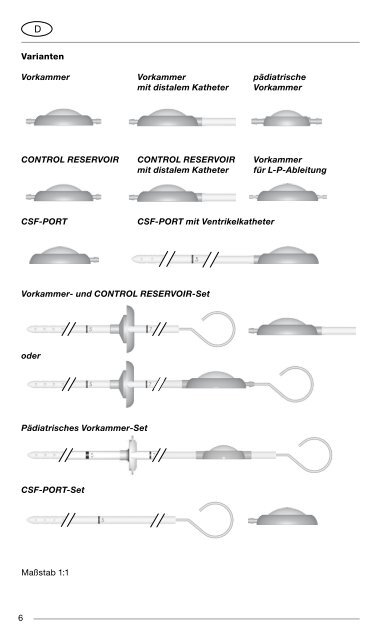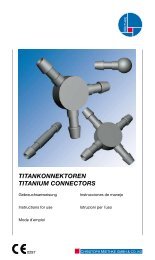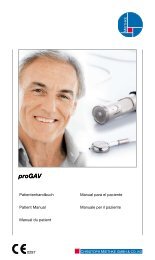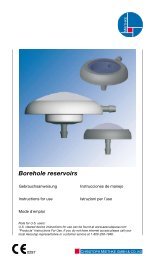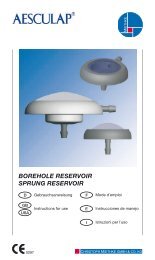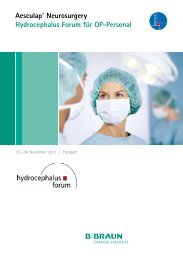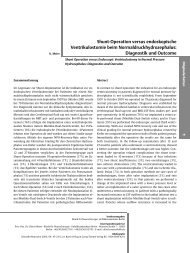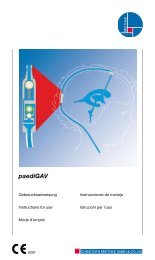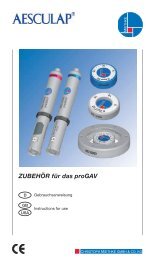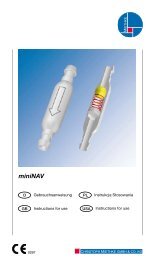Prechamber - Christoph Miethke GmbH & Co. KG
Prechamber - Christoph Miethke GmbH & Co. KG
Prechamber - Christoph Miethke GmbH & Co. KG
You also want an ePaper? Increase the reach of your titles
YUMPU automatically turns print PDFs into web optimized ePapers that Google loves.
6<br />
D<br />
Varianten<br />
Vorkammer Vorkammer pädiatrische<br />
mit distalem Katheter Vorkammer<br />
CONTROL RESERVOIR CONTROL RESERVOIR Vorkammer<br />
mit distalem Katheter für L-P-Ableitung<br />
CSF-PORT CSF-PORT mit Ventrikelkatheter<br />
Vorkammer- und CONTROL RESERVOIR-Set<br />
oder<br />
Pädiatrisches Vorkammer-Set<br />
CSF-PORT-Set<br />
Maßstab 1:1<br />
Indications<br />
The prechamber and the CONTROL<br />
RESERVOIR are used in cases of hydrocephalus<br />
to remove cerebrospinal fluid<br />
and monitor pressure.<br />
Description<br />
One possible treatment of hydrocephalus<br />
is the implantation of a shunt system that<br />
achieves drainage of cerebrospinal fluid<br />
from the ventricles of the brain to an<br />
appropriate region of the body (in most<br />
instances to the abdominal cavity). This<br />
shunt system consists of a series of catheters<br />
and a differential pressure valve.<br />
In addition, the option a prechamber<br />
also exists. It then becomes possible to<br />
measure intraventricular pressure, inject<br />
medication and check the status of the<br />
valve. With the CONTROL RESERVOIR<br />
it is possible to flush CSF towards the<br />
valve due to a nonreturn valve in the proximal<br />
inlet connector of the reservoir. By<br />
this mechanism a flow in the direction of<br />
the proximal catheter is avoided during<br />
the pumping procedure. The volume per<br />
pump procedure is approx. 0.25 ml. The<br />
opening pressure of the shunt system is<br />
not increased by the implantation of the<br />
CONTROL RESERVOIR.<br />
Caution<br />
Frequent pumping of the CONTROL<br />
RESERVOIR can lead to an excessive<br />
drainage and thus to unphysiological<br />
pressure situations. The patient<br />
should be informed about the risk.<br />
Its solid titanium base is highly punctureresistant.<br />
A puncture of the prechamber<br />
or the CONTROL RESERVOIR should be<br />
performed as perpendicular to the reservoir<br />
surface as possible with a cannula of<br />
max. 0,9 mm. 30 times of punctures are<br />
able without any restrictions.<br />
USA<br />
Fig. 1: CONTROL RESERVOIR<br />
GB<br />
The reservoirs are available in various<br />
product configurations (individually or as<br />
a set) and as a CSF-PORT.<br />
The CSF-PORT has only one lateral connector<br />
for the ventricular catheter.<br />
A pediatric prechamber is available adapted<br />
to the size of children‘s skulls.<br />
Fig. 2 CSF-PORT<br />
Implantation<br />
nonreturn valve<br />
proximal connector<br />
When implanting a reservoir, care must be<br />
taken to ensure catheters are secured by<br />
means of a ligature, if this has not already<br />
been done by the catheter manufacturer.<br />
The reservoirs are intended for use with<br />
catheters with an inner diameter of approx.<br />
1.2 mm and an outer diameter of<br />
approx. 2.5 mm. When implanting a reservoir<br />
set, the neurosurgeon should determine<br />
how the procedure is to be performed<br />
in accordance with experience. The<br />
ventricle catheter is implanted with the aid<br />
of a introducing stylet, after which it can<br />
be brought through the deflector into the<br />
90°-angle. During this process (and prior<br />
to implantation of the ventricular catheter),<br />
the deflector can be precisely adjusted,<br />
and then used as a stop. The reservoir is<br />
used in conjunction, and is connected to<br />
a complete shunt system. A final check of<br />
the complete shunt system is recommended<br />
to ensure that it is not obstructed in<br />
any way.<br />
7


